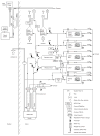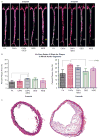Comparative effects of inhaled diesel exhaust and ambient fine particles on inflammation, atherosclerosis, and vascular dysfunction
- PMID: 20462391
- PMCID: PMC3073494
- DOI: 10.3109/08958371003728057
Comparative effects of inhaled diesel exhaust and ambient fine particles on inflammation, atherosclerosis, and vascular dysfunction
Abstract
Ambient air PM(2.5) (particulate matter less than 2.5 mum in diameter) has been associated with cardiovascular diseases (CVDs), but the underlying mechanisms affecting CVDs are unknown. The authors investigated whether subchronic inhalation of concentrated ambient PM(2.5) (CAPs), whole diesel exhaust (WDE), or diesel exhaust gases (DEGs) led to exacerbation of atherosclerosis, pulmonary and systemic inflammation, and vascular dysfunction; and whether DEG interactions with CAPs alter cardiovascular effects. ApoE(-/-) mice were simultaneously exposed via inhalation for 5 hours/day, 4 days/week, for up to 5 months to one of five different exposure atmospheres: (1) filtered air (FA); (2) CAPs (105 microg/m(3)); (3) WDE (DEP = 436 microg/m(3)); (4) DEG (equivalent to gas levels in WDE group); and (5) CAPs+DEG (PM(2.5): 113 microg/m(3); with DEG equivalent to WDE group). After 3 and 5 months, lung lavage fluid and blood sera were analyzed, and atherosclerotic plaques were quantified by ultrasound imaging, hematoxylin and eosin (H&E stain), and en face Sudan IV stain. Vascular functions were assessed after 5 months of exposure. The authors showed that (1) subchronic CAPs, WDE, and DEG inhalations increased serum vascular cell adhesion molecule (VCAM)-1 levels and enhanced phenylephrine (PE)-induced vasoconstriction; (2) for plaque exacerbation, CAPs > WDE > DEG = FA, thus PM components (not present in WDE) were responsible for plaque development; (3) atherosclerosis can exacerbated through mechanistic pathways other than inflammation and vascular dysfunction; and (4) although there were no significant interactions between CAPs and DEG on plaque exacerbation, it is less clear whether the effects of CAPs on vasomotor dysfunction and pulmonary/systemic inflammation were enhanced by the DEG coexposure.
Conflict of interest statement
Support for this study was from a center grant (ES 00260) and a research grant (ES015495) from the NIEHS; and from a research grant from the Health Effects Institute. Qinghua Sun was supported by a NIH grant (ES016588).
Figures





References
-
- Adar SD, Gold DR, Coull BA, Schwartz J, Stone PH, Suh H. Focused exposures to airborne traffic particles and heart rate variability in the elderly. Epidemiology. 2007;2007(18):95–103. - PubMed
-
- Air Quality Expert Group. Particulate Matter in the United Kingdom. London: Defra; 2005.
-
- Boren HG. Carbon as a carrier gas mechanism for irritant gases. Arch Environ Health. 1964;8:127–132. - PubMed
Publication types
MeSH terms
Substances
Grants and funding
LinkOut - more resources
Full Text Sources
Research Materials
Miscellaneous
